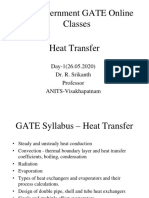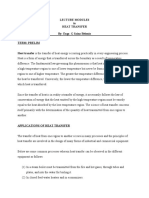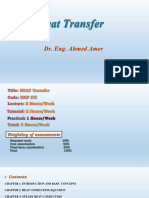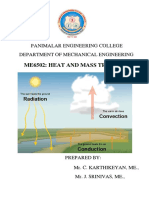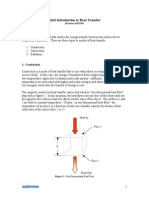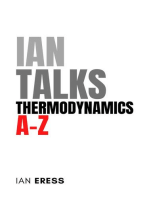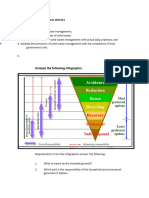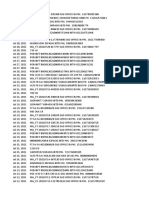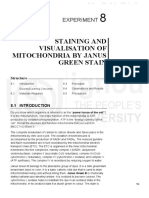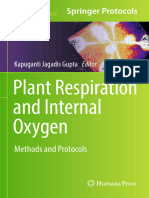Heat Transfer Lecture Notes
Uploaded by
John ValenzonaHeat Transfer Lecture Notes
Uploaded by
John ValenzonaOVERVIEW
HEAT TRANSFER
• It is the movement of heat from one body to
another by means of conduction, convection, or
radiation.
• Heat can transfer between the surface of a solid
conductor and the surrounding medium whenever
temperature gradient exists.
MODES OF HEAT TRANSFER
• Conduction – is a mode of heat transfer in which heat is
transferred by molecular interaction through bodies in
contact.
• Convection – is a mode of heat transfer in which heat is
transferred due to the mixing and motion of particles of a
substance. Transfer of thermal energy occurs in a fluid
when warm material flows so as to displace
Free/Natural Convection – the substance moves
because of the decrease in its density which is
caused by increase in temperature. It occurs
whenever heat flows between a solid and fluid, or
between fluid layers. As a result of heat exchange,
change in density of effective fluid layers taken
place, which causes upward flow of heated fluid.
If this motion is associated with heat transfer
mechanism only, then it is called Natural
Convection
Forced Convection – the substance moves because of
the application of mechanical power such that
of a fan, pumps, gravity where the movement
of the fluid is enforced.
• Radiation – is the mode of heat transfer in which heat
is transferred between bodies by energy propagating
electromagnetic waves.
ASSIGNMENT NO. 1
Give at least three examples of each
mode of heat transfer and discuss
each.
PROPERTIES OF HEAT TRANSFER MATERIALS
Thermal Conductivity – It indicates how fast heat will
flow in a given material.
Specific Heat - The heat quantity needed to raise the
temperature of the unit mass of a substance by 1 0C.
Emissivity – It is the ratio of actual to ideal emmisive
power and varies widely with the surface condition
of the material. It is low with highly polished
material. It is high with most nonmetals and
increases with increase in temperature.
Emissivity is a property of a material that describes its
ability to emit thermal radiation. It is the measure of how
efficiently a surface emits thermal energy compared to an
ideal black body at the same temperature. A black body is
an object that absorbs all incident radiation and emits
radiation over a wide range of wavelengths.
The emissivity of a material is represented by a value
between 0 and 1. A value of 0 indicates that the material is
a perfect reflector and does not emit any radiation (like a
mirror), while a value of 1 indicates that the material is a
perfect emitter, and it emits thermal radiation as
efficiently as a black body at the same temperature.
Dull and dark surfaces tend to have higher emissivity values
since they absorb and emit thermal radiation more effectively,
while shiny and light-colored surfaces typically have lower
emissivity values as they reflect more radiation.
Emissivity is an essential factor in various engineering and
scientific applications, such as in the design of heat transfer
systems, thermal imaging, temperature measurements, and
infrared thermography. Accurate knowledge of emissivity
helps in understanding how a material interacts with thermal
radiation and influences its thermal behavior.
Surface conductance - It indicates how fast heat will
flow in a unit area of a given material.
Surface conductance, also known as thermal
conductance or convective conductance, is a measure of
how effectively heat is transferred through a solid
surface by convection. It is influenced by factors such as
surface roughness, surface orientation, and the properties
of the fluid medium.
Surface conductance quantifies the rate at which heat
flows across a unit area of a solid surface due to the
temperature difference between the surface and the
surrounding fluid (usually air). It depends on factors
such as the material properties of the surface, the fluid
properties, and the nature of the flow (laminar or
turbulent).
In engineering and heat transfer analysis, understanding the
surface conductance is crucial in designing heat exchange
systems, evaluating the thermal performance of materials,
and predicting temperature distributions on surfaces
exposed to convective heat transfer. It is a fundamental
parameter in the study of heat transfer and plays a
significant role in various industrial applications, including
cooling systems, HVAC (heating, ventilation, and air
conditioning), and thermal insulation design.
ASSIGNMENT NO. 2
1. Explain why most metals have high thermal
conductivity?
2. Why is water’s specific heat so high?
3. What factors affect emmisivity?
4. How do you distinguish thermal conductivity
from surface conductance. Discuss briefly.
CONDUCTION THROUGH A
PLANE WALL
The terms "steady state," "unidirectional flow
of heat," and "homogeneous plane wall" all
relate to the concept of heat transfer in
thermodynamics and describe specific conditions
and scenarios.
Steady State:
It refers to a situation where the temperature within
a system or a material doesn't change with time.
This means that the rate of heat transfer into the
system is equal to the rate of heat transfer out of the
system. In other words, the system has reached a
thermal equilibrium where the temperature
distribution remains constant over time.
Unidirectional Flow of Heat:
It refers to the heat transfer occurring in only one
direction within a system. For example, in the context
of a wall, it means that heat is flowing from one side of
the wall to the other side without any lateral or
backflow. This simplifies the analysis and calculations
of heat transfer because it reduces the problem to one-
dimensional heat conduction.
Homogeneous Plane Wall:
A homogeneous plane wall is a material that is
uniform throughout its thickness and has no
variation in its thermal or physical properties
across its cross-section. In this context, a "plane
wall" refers to a flat and thin structure, and
"homogeneous" means that the material's
properties (such as thermal conductivity) are
constant throughout the wall.
The derivation of Fourier's equation for heat conduction
involves applying the principles of conservation of
energy and Fourier's law of heat conduction.
Step 1: Conservation of Energy
Consider a small element of the material with a length
Δx. The heat entering the element from the left side is Q in,
and the heat leaving the element from the right side is
Qout.
According to the principle of conservation of energy, the
net heat added to the element should be equal to the
change in internal energy: Qnet = ΔU
Step 2: Definition of Heat Flux
Heat flux (q) is the amount of heat passing
through a unit area perpendicular to the direction
of heat transfer. Mathematically, it is defined as:
q= Q/A
Where:
Q is the heat transferred through an area A.
Step 3: Applying Fourier's Law
According to Fourier's law of heat conduction,
heat flux (q) is proportional to the temperature
gradient (dT/dx):
Q = −k dT/dx
Where:
k is the thermal conductivity of the material.
Step 4: Substituting into Conservation of
Energy
Substitute the expression for heat flux (q)
from Fourier's law into the conservation of
energy equation.
Step 5: Equating Derivatives and Heat
Transfer Rate
Since dU/dx represents the rate of change of
internal energy with respect to distance, it is
also proportional to the rate of heat transfer
(Q).
CONDUCTION THROUGH A PLANE WALL
For steady state, unidirectional flow of heat through a
homogeneous plane wall, Fourier’s equation gives the heat by
conduction as:
1 2
kA (t1 – t2)
k
Q = Q
x
Where:
Q = heat transmitted, W x
A = heat transfer area, m2
t1 = hot side temperature, 0C or K
t2 = cold side temperature, 0C or K
x = thickness of the wall, m
k = thermal conductivity, W/m-0C or W/m-K
EXAMPLES:
1. Calculate the energy transfer rate in W/m2 across 6 in. wall
of firebrick with a temperature difference across the wall
of 500C. The thermal conductivity of the firebrick is 0.65
BTU/hr-ft-0F at the temperature interest.
Solution: 1 2
Δt = 500C
Q = kAΔt / x t1 t2
Q/A = kΔt / x Q
where:
Δt = 50 (9/5) = 900F
x = 6 in = 0.5 ft. x = 6 in.
k = 0.65 BTU/hr-ft-0F
Then:
Q/A = 0.65(90) / 0.50
Q/A = 117 BTU/hr-ft2 (3.153 W/m2 / 1 BTU/hr-ft2)
Thus:
Q/A = 368.9 W/m2
2. Calculate the heat transfer per hour through a solid brick
wall 6 m long, 2.9 m high, and 225 mm thick, when the
outer surface is at 50C and the inner surface 170C, the
coefficient of thermal conductivity of the brick being 0.6
W/m-K.
Solution:
Q = kAΔt / x
= 0.6 [(6)(2.9)] (17 – 5) / 0.225
Q = 556.8 Watts
PLATE NO. 1
1. A metal rod is 10 cm long and has a diameter of 2 cm
one end is in contact with steam at 100 0C while the
other end contacts a block of ice at 0 0C. The
cylindrical surface of the rod is carefully insulated so
heat flows only from one end to end. In a time of 20
minutes, 320 grams of ice melts. What is the thermal
conductivity of the metal?
2. A hollow sphere has an outside radius of 1 m and is
made of polystyrene foam with a thickness of 1 cm. A
heat source inside keeps the inner surface 5.20 0C
hotter than the outside surface. How much power is
produced by the heat source? The thermal
conductivity of polystyrene foam is 0.033 W/m-0C.
3. Find the thermal conductivity in W/m- 0K of the 500 cm thick material
with an area of 50 000 cm2 and a temperature difference of 10 0K if the heat
transmitted during 2 hours test is 2000 KJ.
4. The thermal insulation of a woolen glove may be regarded as being
essentially a layer of quiescent air 3 cm thick, of conductivity 5.7 x 10 -6
Kcal/ m-s-0C. How much heat does a person loss in Cal/min from his hand
of area 200 cm2 and skin temperature 35 0C on a winter day at -5 0C?
5. A single-thickness glass window on a house actually has layers of
stagnant air on its two surfaces. But if it did not, how much heat would
flow out of an 80 cm x 40 cm x 3 mm window each hour on a day when the
outside temperature was precisely 00C, and the inside temperature was
180C? For glass, k = 0.84 W/m-0K.
6. What temperature gradient must exist in an aluminum rod for it to
transmit 8 Cal/sec /cm2 of cross-section down the rod? The thermal
conductivity for aluminum is 210 W/m-0K.
CONDUCTION THROUGH COMPOSITE PLANE WALLS
It refers to the heat transfer process that occurs
when heat flows through a multi-layered wall made up of
different materials. The goal is to analyze how heat
transfers through these layers and to determine the overall
thermal behavior of the composite wall. This is an
important concept in heat transfer and is often encountered
in building construction, insulation design, and various
engineering applications.
Components of a Composite Wall:
A composite plane wall typically consists of
multiple layers of different materials with distinct
thermal properties. These layers can include
materials like insulation, concrete, metal, wood, and
more. Each layer has its own thermal conductivity
(k), thickness (d), and possibly different
temperatures on each side.
Heat Transfer Analysis:
The heat transfer through a composite wall can
be analyzed using principles from Fourier's Law of
Heat Conduction, which states that heat transfer rate
(Q) is proportional to the temperature gradient (dT/dx)
and the area (A) through which heat is flowing, and
inversely proportional to the thermal resistance (R) of
the material:
Q = k A (dT/dx)
CONDUCTION THROUGH COMPOSITE PLANE WALLS
For composite wall, if the heat flows in series first through one
slab and then another, Fourier’s equation can be applied as:
k1A(t1 –t2) AΔt
Q1 = Q =
x1 RT
k2A(t2 – t3) A (t1 – t4)
Q2 = =
x2 x1 + x2 + x3
k1 k2 k3
k3A (t3 – t4)
Q =
Where:
RT = overall resistance/overall heat
resistance
Q = Q1 = Q2 = Q3 for steady
state heat transfer
1 2 3 4
k1 k2 k3
t1 t2
Q
Q1 t3 t4
Q2 Q3
x1 x2 x3
Understanding conduction through composite
plane walls is crucial for designing energy-efficient
buildings, effective insulation systems, and other
structures that require controlled heat transfer. By
selecting appropriate materials and optimizing layer
thicknesses, engineers and architects can minimize heat
loss or gain, leading to more comfortable and energy-
efficient environments.
SAMPLE PROBLEMS
1. A vertical furnace wall is made up of an inner wall of
firebrick 20 cm thick followed by insulating brick 15 cm
thick and an outer wall of steel 1 cm thick. The surface
temperature of the wall adjacent to the combustion
chamber is 12000C while that of the outer surface of
steel is 500C. The thermal conductivities of the wall
material in W/m-K are: firebrick, 10; insulating brick,
0.26; and steel, 45. Neglecting the film resistances and
contact resistance of joints, determine the heat loss per
square meter of wall area.
Insulating
firebrick brick steel
1 2 3 4
k1 k2 k3
Combustion t1 =12000C t2 = 500C Q Outer
chamber Q1 t3 t4 area
Q2 Q3
x1= 20 cm x2= 15 cm x3= 1 cm
k1 = 10 W/m-oK
k2 = 0.26 W/m-oK
k3 = 45 W/m-oK
Solution:
Q = t1 – t4
A x1 + x2 + x3
k1 k2 k3
1200 – 50
=
0.20 + 0.15 + 0.01
10 0.26 45
= 1.93 W/m2
ASSIGNMENT NO. 3
1. A cold storage compartment is 4.5 m long by 4 m wide by
2.5 m high. The four walls, ceiling and floor are covered to
a thickness of 150 mm with insulating material which has
a coefficient of thermal conductivity of 5.8 x 10-2 W/m-K.
Calculate the quantity of heat leaking through the
insulation per hour when the outside and inside face
temperatures of the material is 150C and -50C
respectively.
2. The surface temperature of the hot side of the furnace
wall is 12000C. It is desired to maintain the outside of the
wall at 380C. A 152 mm of refractory silica is used adjacent
to the combustion chamber and 10 mm of steel covers the
outside. What thickness of insulating bricks is necessary
between refractory and steel, if the heat loss should be
kept at 788 W/m2? Use k = 13.84 W/m-K for refractory
silica; 0.15 for insulating brick, and 45 for steel.
CONDUCTION FROM FLUID TO FLUID
When dealing with fluids, it's important to
consider how heat is conducted within the
fluid itself and between different fluid
layers or between a fluid and solid walls.
Conduction within a Fluid:
In a fluid, such as a liquid or a gas, heat is conducted
through molecular interactions. As molecules move
around, they collide with each other, transferring
kinetic energy (thermal energy) from faster-moving
particles to slower-moving ones.
Fluids with higher surface film conductance will
conduct heat more effectively.
Conduction between Fluid and Solid Walls:
When a fluid is in contact with a solid wall, heat
can be conducted from the solid into the fluid or
vice versa.
The rate of heat transfer depends on several
factors, including the temperature difference
between the fluid and the wall, the surface film
conductance and thermal conductivity of both the
fluid and the solid, and the thickness of the
boundary layer (the region near the wall where
heat transfer occurs).
In cases where the temperature difference between
the fluid and the wall is significant, a temperature
gradient exists within the fluid near the wall. This
gradient drives the conduction of heat from the
higher-temperature region to the lower-
temperature region.
The heat transfer coefficient, often denoted as ‘U,'
quantifies the rate of heat transfer between the
fluid and the wall. It depends on the properties of
both the fluid and the solid surface, as well as the
flow conditions.
Conduction between Fluid Layers:
In many fluid systems, especially those involving
complex flows, there can be temperature differences
between different fluid layers.
Heat is conducted between these fluid layers through
the same principles of molecular interactions. The
molecules in adjacent fluid layers collide and
exchange thermal energy, resulting in heat transfer
from warmer to cooler regions.
The rate of heat conduction between fluid
layers depends on the temperature gradient
across the layers and the fluid's thermal
conductivity.
The use of mathematical models are crucial, such as
Fourier's law of heat conduction, to quantify and
predict heat transfer in these scenarios.
CONDUCTION FROM FLUID TO FLUID
Qi = hiA (ti – t1) k3A(t3 – t4)
Q3 =
Qo = hoA (t4 – to) x3
k1A (t1 – t2)
Q1 =
x1
k2A(t2 – t3)
Q2 =
x2
i 1 2 3 4 o
hi k1 k2 k3 ho
FLUID
FLUID t1 t2 to
ti Q
Q1 t3 t4
Q2 Q3
x1 x2 x3
AΔt A (ti – to)
Q = =
RT 1 + x 1 + x2 + x 3 + 1
hi k1 k2 k3 ho
Where:
hi = surface film conductance on hot side, W/m2-0C
ho = surface film conductance on cold side, W/m2-0C
OVERALL CONDUCTANCE OR OVERALL
COEFFICIENT OF HEAT TRANSFER
1 1
U = =
RT 1 + x1 + x2 + 1
hi k1 k2 ho
HEAT TRANSFER IN TERMS OF OVERALL CONDUCTANCE
Q = U A Δt
SAMPLE PROBLEMS
1. A heat exchanger is to be designed for the following
specifications: hot gas temperature = 11450C; cold gas
temperature = 450C; unit surface conductance on the hot
side = 230 W/m2-0K; unit surface conductance on the cold
side = 290 W/m2-0K; thermal conductivity of the metal wall
= 115W/m-0K. Find the maximum thickness of the metal
wall between the hot gas and cold gas so that the maximum
temperature of the wall does not exceed 5450C.
ti = 11450C t1 = 5450C to = 450C
hi = 230 W/m2-0K k = 115 W/m- K
o
ho = 290 W/m2-0K
Q
Hot Cold
gas gas
x
Solution:
Q = ti – to
A 1 + x + 1
hi k ho
Solving for Q/A:
Q/A = hi (ti – t1) = 230(1145 – 545) = 138,000 W/m2
Then;
1145 – 45
138,000 =
1 x 1
2. A cubical tank of 2 m sides is constructed of metal
plate 12 mm and contains water at 750C. The
surrounding air temperature is 160C. Calculate the
overall heat transfer coefficient from water to air. Take
the coefficient of thermal conductivity of the metal as
48 W/m-0K, the coefficient of heat transfer of water is
2.5 KW/m2-0K and the coefficient of heat transfer of
the air is 16 W/m2-0K.
Solution:
U = overall heat transfer coefficient
U = 1 / RT
Where:
RT = 1 + x + 1
hwater k hair
1 + 0.012 + 1
=
2.5 x 103 48 16
RT = 0.063 m2-0C/W
Then;
U = 1 / 0.063 = 15.84 W/m2-0C
PLATE NO. 2
1. One insulated wall of a cold-storage compartment is 8 m long
by 2.5 m high and consists of an outer steel plate 18 mm thick.
An inner wood wall 22.5 mm thick, the steel and wood are 90
mm apart to form a cavity which is filled with cork. If the
temperature drop across the extreme faces of the composite
wall is 15 0C, calculate the heat transfer per hour through the
wall and the temperature drop across the thickness of the cork.
Take the coefficients of thermal conductivity for steel, cork
and wood as 45, 0.045, and 0.18 W/m 0K, respectively.
2. Hot gases at 280 0C flow on one side of a metal plate of 10
mm thickness and air at 35 0C flows on the other side. The
heat transfer coefficient of the gases is 31.5 W/m 2 0K and that
of the air is 32 W/m2 0K. Calculate the over-all transfer
coefficient.
3. A composite furnace wall is made up of a 12 in. lining of
magnesite refractory brick, a 5 in. thickness of 85 %
magnesia, and a steel casing 0.10 in. thick. Flue gas
temperature is 2200 0F and the boiler room is at 80 0F. Gas
side film coefficient is 15 BTU/hr-ft2-0F and air side is 4.
Determine the thermal current Q/A.
4. If total resistance to heat flow of a composite wall is
3.0875 m2-0K/W, what is the over-all transfer coefficient of
the wall?
CONDUCTION THROUGH PIPES
It involves the transfer of thermal energy from
one point to another within a solid material
(the pipe) due to a temperature difference.
Several theories and principles govern the
conduction of heat through pipes:
Fourier's Law of Heat Conduction:
It states that the rate of heat transfer (Q) through
a material is directly proportional to the
temperature gradient (dT/dx) and the cross-
sectional area (A) perpendicular to the direction
of heat flow, and inversely proportional to the
material's thermal conductivity (k).
Steady-State Condition:
Conduction through pipes can occur in both
steady-state and transient (unsteady-state)
conditions. In steady-state conduction, the
temperature distribution within the pipe remains
constant over time.
Thermal Resistance:
In many practical applications, pipes are not
perfectly conductive, and heat transfer is
influenced by thermal resistance. The concept
of thermal resistance is analogous to electrical
resistance and is used to describe how
temperature differences across various
components in a heat conduction system affect
the overall heat transfer rate.
Composite Pipes:
Pipes can be made from various materials,
including metals, plastics, and ceramics, each
with its own thermal conductivity. When
dealing with composite pipes made of different
materials or layers, you need to consider the
thermal resistance of each layer to accurately
calculate heat conduction.
Insulation:
To minimize heat loss or gain in pipes,
insulation materials are often used to reduce
the thermal conductivity of the outer layer of
the pipe. This is especially important in
applications where maintaining a specific
temperature is crucial, such as in the
transportation of hot or cold fluids.
Boundary Conditions:
The boundary conditions at the ends of the
pipe, such as the temperature at the inlet and
outlet or the presence of additional heat
sources or sinks, can significantly influence
the conduction of heat through pipes.
Understanding the thermal properties of the
pipe material, the geometry of the pipe, and
the boundary conditions is crucial for
analyzing and designing efficient heat transfer
systems involving pipes.
CONDUCTION THROUGH PIPE
In conduction through pipe, assume that heat flows in the
radial direction from inside to outside surface. Fourier’s r2
equation gives the heat loss as:
Δt t1 – t2 t1 – t 2
Q = = = Q
r1
RT ln(r2/r1) ln(d2/d1) L
2πkL 2πkL
2
Where:
RT = resistance to heat flow Q
1
CONDUCTION THROUGH COMPOSITE PIPE
t 1 – t2 t2 – t3
Q1 = Q2 =
ln(r2/r1) ln(r3/r2)
2πk1L 2πk2L
Δt t1 – t3
Q = =
RT ln(r2/r1) + ln(r3/r2)
2πk1L 2πk2L
k1 k2
Q
1
2
3
SAMPLE PROBLEMS
1. A pipe 200 mm outside diameter and 20 m length is
covered with a layer, 70 mm thick of insulation having a
thermal conductivity of 0.05 W/m-0K and a thermal
conductance of 10 W/m2-0K at the outer surface. If the
temperature of the pipe is 3500C and the ambient
temperature is 150C, calculate the external surface
temperature of the lagging. nominal
2. Calculate the heat loss per linear foot from a 10 in. nominal
pipe(outside diameter = 10.75 in.) covered with a
composite pipe insulation consisting of 1 ½ in. of insulation
I placed next to the pipe and 2 in. of insulation II placed
upon insulation I. Assume that the inner and outer surface
temperatures of the composite insulation are 7000F and
1000F respectively, and that the thermal conductivity of
material I is 0.05 BTU/hr-ft-0F and for material II is 0.039
BTU/hr-ft-0F.
CONDUCTION FROM FLUIDS THROUGH PIPES
Qi = hi Ai (ti – t1)
Qo = ho Ao (t3 – to)
Δt t1 – t 2
Q1 = =
R1 ln (r2/r1)
2πk1L
Δt t2 – t 3
Q2 = =
R2 ln (r3/r2)
2πk2L
Δt ti - to
Q = =
RT 1 + ln(r2/r1) + ln(r3/r2) + 1
A i hi 2πk1L 2πk2L Aoho
HEAT TRANSFERRED IN TERMS OF THE OVERALL
CONDUCTANCE
Q = Ui Ai Δt ; Q = Uo Ao Δt
SAMPLE PROBLEM
1. Steam, initially saturated at 2.05 Mpa, passes through a 10.10
cm standard steel pipe for a totaldistance of 152 m. The steam
line is insulated with 5.08 cm thickness of 85% magnesia. For
an ambient temperature of 220C, what is the quality of the
steam which arises at its destination if the
mass flow rate is 0.125 kg steam per second?
Properties of Steam:
Pressure Temperature Enthalpy
hf hfg hg
2.05 Mpa 231.670C 914.52 KJ/kg 1885.5 KJ/kg 2800.00
KJ/kg
Note: k for 85% magnesia is 0.069W/m-K and ho for still air is 9.36 W/m2-K
ASSIGNMENT NO. 4
1. An insulated steam pipe located where the ambient
temperature is 320C, has an inside diameter of 50 mm with 10
mm thick wall. The outside diameter of the corrugated asbestos
insulation is 125 mm and the surface coefficient of still air, ho =
12 W/m2-K. Inside the pipe is steam having a temperature of
1500C with film coefficient hi = 6000 W/m2-K. Thermal
conductivity of pipe and asbestos insulation are 45 and 0.12
W/m-K ,respectively. Determine the heat loss per unit length
pipe.
2. An uninsulated iron pipe of 20 ft length conveys steam at 3850F
with an average ambient temperature of 850F. The inside and
outside diameter are 5.761 and 6.625 in., respectively. k = 30
BTU/hr-ft-0F, hi = 1000 BTU/hr-ft2-0F, h0 = 2 BTU/hr-ft2-0F.
Compute the total heat lost.
CONVECTION
Convective heat transfer is one of the primary
mechanisms by which heat is transferred from
one place to another, typically involving the
movement of fluids (liquids or gases). This
process occurs due to the bulk motion of the
fluid itself, which carries thermal energy from a
hotter region to a cooler one.
Definition of Specific Heat:
Specific heat (often denoted as cp for
constant pressure or cv for constant volume) is a
material property that measures the amount of
heat energy required to raise the temperature of
a unit mass of a substance by one degree
Celsius (or one Kelvin). It quantifies the
substance's ability to store or release heat
energy.
Convective heat transfer primarily occurs
through two modes:
a. Natural Convection: This mode of heat
transfer arises due to density differences caused
by temperature variations in a fluid. When a fluid
near a heated surface becomes warmer, it
becomes less dense and tends to rise. Cooler
fluid then replaces it, creating a continuous
circulation pattern known as a convection cell.
An example of natural convection is the rising of
warm air near a radiator.
b. Forced Convection: Forced convection
involves the use of external means, such as
pumps or fans, to induce fluid motion. This
mode of heat transfer is often more efficient
than natural convection and is commonly used
in engineering applications. For example, the
circulation of coolant in a car's engine is a form
of forced convection.
Convection Heat Transfer Equation: The rate of heat
transfer by convection (Q) can be described by Newton's Law
of Cooling/Heating, which states:
Q=h A ∆T
where:
Q = the rate of heat transfer (in watts or Btu/hr).
h = the convective heat transfer coefficient (in
W/(m²·K) or Btu/(hr·ft²·°F)), which depends on the
specific conditions of the fluid flow and the solid
surface.
A= the surface area through which heat is being
transferred (in square meters or square feet).
∆T= the temperature difference between the surface and
the bulk fluid (in Kelvin or degrees Fahrenheit).
Specific Heat's Role:
Specific heat (cp) is relevant in convective heat
transfer because it affects the temperature
difference (∆T) in the convection equation. As
specific heat quantifies how much energy is
required to raise the temperature of a substance,
a material with a higher specific heat will have a
smaller temperature change for a given amount of
heat transfer.
Q = m Cp Δt = m Cp (t2 – t1)
Where:
m = mass flow rate, kg/s
Cp = specific heat, J/kg-0C
Δt = temperature difference
In summary, convective heat transfer involves the
transfer of thermal energy through the motion of
fluids, and the specific heat of the fluid plays a
role in determining the temperature difference
between the solid surface and the bulk fluid.
Understanding the principles of convection and
the specific heat of the involved materials is
essential for engineering and heat transfer
applications.
SAMPLE PROBLEMS
1. A heat exchanger was installed purposely to cool 0.50 kg
of gas per second. Cpgas = 1.2247 KJ/kg-K. The gas is cooled
from 1500C to 800C. Water is available at the rate of 0.30
kg/s and at a temperature of 120C. Calculate the exit
temperature of the water.
2. Brine enters a cooler at the rate of 50 m3/hr at 150C.
Specific heat and specific gravity of brine are 1.07 KJ/kg-0K
and 1.1, respectively. Calculate the heat transferred in KW.
3. A calorimeter contains 0.66 kg of turpentine at 10.60C.
When 0.147 kg of alcohol at 750C is added, the temperature
rises to 25.20C. The specific heat of turpentine is 1.95 x 103
J/kg-0C and the calorimeter is thermally equivalent to 30
grams of water. Find the specific heat of alcohol.
4. A copper rod whose diameter is 2 cm and length 50 cm
has one end in boiling water, the other end in a jacket
cooled by flowing water which enters at 100C. The thermal
conductivity of the copper is 0.102 KCal/m-s-0C. If 0.20 kg of
water flows through the jacket in 6 min, by how much does
the temperature of the water increase?
PLATE NO. 3
1. A pipe with an outside diameter of 2.5 in. is insulated with
a 2 in. layer of asbestos (ka = 0.396 BTU-in / hr-ft2-0F),
followed by a layer of cork 1.5 in. thick (kc = 0.30 BTU-in /
hr-ft2-0F). If the temperature of the outer surface of the
cork is 90 0F, calculate the heat loss per 100 ft of insulated
pipe.
2. A thick-walled tube of stainless steel (18% Cr, 8% Ni, k =
19 W/m-0C) with 2-cm inner diameter and 4-cm outer
diameter is covered with a 3 cm layer of asbestos
insulation (k = 0.2 W/m-0C).If the inside wall temperature
of the pipe is maintained at 600 0C, calculate the heat loss
per meter of length. Also calculate the tube-insulation
interface temperature.
3. An insulated iron pipe having inside diameter of 5.761 in.
and outside diameter of 6.625 in. conveys steam at 385 0F
with an average ambient temperature of 85 0F. The inside
surface coefficient is 1000 BTU/hr-ft2-0F and the outside
surface coefficient is 2 BTU/hr-ft2-0F. If the cost of the fuel is
250 pesos per 106 BTU with the net energy conversion
efficiency of 75%, what is the annual cost of the heat lost?
4. A steam pipe carrying steam at 380 KPa pressure for a
distance of 120 m in a chemical plant is not insulated.
Estimate the saving in steam cost that would be made per
year if this 8 cm steam line were covered with 85% magnesia
pipe covering 5 cm thick. Take room temperature to be 25
0
C, the cost of steam is 65 cents per 1000 kg. K for magnesia
is 0.0745 W/m-0K, unit convective coefficient of room air, h0
= 12 W/m2 0K.
PLATE NO. 4
1. When 200 grams of aluminum at 1000C is dropped into an
aluminum calorimeter (k = 0.909 x 103 J/kg-K) of mass 120
grams and containing 150 grams of kerosene at 150C the
mixture reaches a temperature of 500C, what is the
specific heat of kerosene?
2. The temperature of a sample of molten lead near its
temperature of solidification is falling at the rate of 6
KJ/min. If the lead continues to lose heat at this same rate
and takes 35 min. to solidify completely, what is the heat
of fusion of the lead? The specific heat of molten lead is
0.126 KJ/kg-K.
3. The mass of copper calorimeter is 0.28 kg and it contains
o.4 kg of water at 150C. Taking the specific heat of copper
as 0.39 KJ/kg-K, calculate the heat required to raise the
temperature to 200C.
4. A water brake coupled to an engine on test absorbs 70 KW
of power. Find the mass flow of fresh water through the
brake in kg/min if the temperature increase of the water is
100C. Assume all the heat generated is carried away by the
cooling water.
5. In an experiment to find the specific heat of lead, a 0.50 kg
of lead shot at a temperature of 510C is poured into an
insulated calorimeter containing 0.25 kg of water at 13.50C
and the resultant temperature of the mixture is 15.50C. If the
water equivalent of the calorimeter is 0.020 kg, find the
specific heat of the lead.
DIMENSIONLESS GROUP IN THE ANALYSIS OF
HEAT CONVECTION
A.REYNOLDS NUMBER, NRE
It is a dimensionless number which is significant in
the design of a model of any system in which the effect of
viscosity is important in controlling the velocities or the flow
pattern of a fluid; equal to the product of density, of
velocity and characteristics length divided by the fluid
viscosity.
NRE = VD / μk = VDρ / μd
WHERE: μk = μd / ρ
Reynolds number, gives the information,
whether the flow is inertial or viscous force
dominant. It tells us whether the flow is
laminar or turbulent.
Reynolds number constitutes an important
criterion of motion in fluids depending on
factors like heat transfer and temperature. It
also considers the density of the fluid.
When a fluid flow at a higher velocity, i.e., at
higher Reynolds number (turbulent condition),
convective heat transfer would be high.
Inertial forces resist a change in the velocity of
an object and are the cause of fluid movement.
These forces are dominant in turbulent flows.
Viscous force tends to keep the layers moving
smoothly one over the other. Inertia forces tend to
move the particles away from the layer. When
viscous force are sufficiently high so that any
disturbance is smoothed down, laminar flow
prevails in pipes
B. PRANDTL NUMBER, NPr
It is a dimensionless number used in the study of
forced and free convection, equal to the dynamic viscosity
times the specific heat at constant pressure divided by the
thermal conductivity.
NPr = μdCp / k
Heat transfer coefficient increases with an increase
in Pr number. The Prandtl number for water is
around 10. So viscous effects cause the velocity
boundary layer to develop about ten times faster
than the thermal boundary layer.
For Prandtl numbers greater than 1, the
transport of momentum dominates over heat
transfer by thermal conduction. In this case,
the velocity boundary layer is larger than the
thermal boundary layer.
Heat transfer increases with the increasing of
Prandtl number for all cases. Both flow and
temperature fields are affected with the
changing of Prandtl number.
The Prandtl number is a dimensionless
quantity that puts the viscosity of a fluid
in correlation with the thermal
conductivity. It therefore assesses the
relation between momentum transport
and thermal transport capacity of a fluid.
C. NUSSELT NUMBER, NNu
It is a dimensionless number used in the
study of forced convection which gives a measure of
the ratio of the total heat transfer to conductive heat
transfer coefficient times the characteristic length
divided by the thermal conductivity.
NNu = hD / k
Nusselt number represents the enhancement
of heat transfer through a fluid layer as a
result of convection relative to conduction
across the same fluid layer.
Nusselt number is an important parameter that
can contribute to a better rate of heat
exchange. It is basically a function of
Reynolds and Prandtl number.
D. GRASHOF NUMBER, NGR
It is a dimensionless number used in the study of the
free convection of a fluid caused by a hot body. It is equal to
the product of the fluids coefficient of thermal expansion,
the temperature difference between the hot body and the
fluid, the cube of a typical dimension of the body and the
square of the fluids density divided by the square of the
fluid’s dynamic viscosity.
NGR = D3ρ2βgΔt / μd2
The significance of the Grashof number is that
it represents the ratio between the buoyancy
force due to spatial variation in fluid density
(caused by temperature differences) to the
restraining force due to the viscosisty of the
fluid.
It establishes the interplay between inertia
force, buoyant force, and viscous force within
fluid flow. This dimensionless parameter plays a
crucial role in the examination of natural
convection heat transfer phenomena.
SAMPLE PROBLEMS
1. Calculate the Reynolds number for water at 800F flowing through a
tube 2 in. in diameter, if the average water velocity and specific
weight is 10 ft/s and 62.4 lb/ft3, respectively. Use a value of the
viscosity as 0.0648 slug/ft-hr.
2. Engine oil at 300C is forced on the surface of a 30-cm-diameter
pipe at a velocity of 1.5 m/s. The pipe is initially heated to a
uniform temperature of 550C. The heat lost by the pipe is 450 W.
The properties of engine oil are: ρ = 876 kg/m 3; k = 0.144 J/s-mOC;
NRE = 1500. Calculate the Prandtl number.
3. A 0.75-Hp heater is constructed of a glass plate with an electrically
conducting film which produces a constant heat flux. The plate is
100 cm by 70 cm and placed in an air stream. The average
temperature difference is 4000F. Calculate the nusselt number
taking k = 0.02624 J/s-mOC at the free stream conditions and
assuming the heat flux flowing along the width of the plate.
You might also like
- Culture Media and Reagent Preparation-Handout0% (1)Culture Media and Reagent Preparation-Handout53 pages
- Heat Transfer:: Differences Between Thermodynamics and100% (1)Heat Transfer:: Differences Between Thermodynamics and11 pages
- AP Government GATE Online Classes: Day-1 (26.05.2020) Dr. R. Srikanth Professor ANITS-VisakhapatnamNo ratings yetAP Government GATE Online Classes: Day-1 (26.05.2020) Dr. R. Srikanth Professor ANITS-Visakhapatnam64 pages
- 1. Introduction to Heat and Mass TransferNo ratings yet1. Introduction to Heat and Mass Transfer53 pages
- Conduction - Part 1 - Heat and Mass TransferNo ratings yetConduction - Part 1 - Heat and Mass Transfer39 pages
- Heat Transfer CHE0301 LECTURE 2 Basics of Heat TransferNo ratings yetHeat Transfer CHE0301 LECTURE 2 Basics of Heat Transfer21 pages
- Basic Concepts: 1.1 Introduction To Heat TransferNo ratings yetBasic Concepts: 1.1 Introduction To Heat Transfer14 pages
- UNIT-2 Basics Of Heat Transfer: q = - kA ΔTNo ratings yetUNIT-2 Basics Of Heat Transfer: q = - kA ΔT17 pages
- Chapter One: - Methods of Heat TransferNo ratings yetChapter One: - Methods of Heat Transfer24 pages
- MODULE 2 - (Heat Thermodynamics) - Lecture OnlyNo ratings yetMODULE 2 - (Heat Thermodynamics) - Lecture Only9 pages
- Lecture Guide 2 Steady State One Dimensional Conduction Heat TransferNo ratings yetLecture Guide 2 Steady State One Dimensional Conduction Heat Transfer6 pages
- Section 2 Block Diagrams & Signal Flow GraphsNo ratings yetSection 2 Block Diagrams & Signal Flow Graphs91 pages
- slidesgo-crafting-narratives-the-art-of-storytelling-through-handmade-creations-20240919025303aZ7pNo ratings yetslidesgo-crafting-narratives-the-art-of-storytelling-through-handmade-creations-20240919025303aZ7p8 pages
- Section 2 Block Diagrams & Signal Flow Graphs (1)No ratings yetSection 2 Block Diagrams & Signal Flow Graphs (1)82 pages
- Written-Activity-1.3-Types-of-Food-ServiceNo ratings yetWritten-Activity-1.3-Types-of-Food-Service2 pages
- Public Health - Intro and Lesson 1 - 2023No ratings yetPublic Health - Intro and Lesson 1 - 202336 pages
- CHEM 2005 - Assignment - 1 - F23 CompleteNo ratings yetCHEM 2005 - Assignment - 1 - F23 Complete6 pages
- A Critical Review of using High Viscosity Friction Reducers as FrNo ratings yetA Critical Review of using High Viscosity Friction Reducers as Fr17 pages
- Chemistry Grade 9 Unit 4 Test Answers ch4-5 Redox Electrolisis EnergeticsNo ratings yetChemistry Grade 9 Unit 4 Test Answers ch4-5 Redox Electrolisis Energetics8 pages
- Chemistry Assignment CH-1 Class X PDF RedoxNo ratings yetChemistry Assignment CH-1 Class X PDF Redox1 page
- Isomerism - DPP-01 (Of Lecture 02) - Yakeen 3.0 2024No ratings yetIsomerism - DPP-01 (Of Lecture 02) - Yakeen 3.0 20243 pages
- Get Solvent Extraction Principles and Practice Revised and Expanded 2nd Edition Jan Rydberg free all chapters100% (11)Get Solvent Extraction Principles and Practice Revised and Expanded 2nd Edition Jan Rydberg free all chapters40 pages










